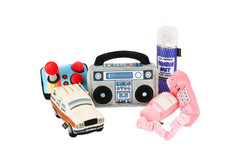As much as we love them, it's easy to forget our furry friends when we're remodeling or redesigning our own spaces. Pet doors and beds are obviously important, but a pet-friendly design strategy goes a long way toward creating a more harmonious household. With a little work and imagination, you can create a stylish space that's comfortable, convenient and clean. We've got six tips to get you thinking about what will work for the pets in your house.
1. Floors and Furniture: Hard surface floors are the way to go for all the reasons you might guess. With hardwood, laminate or tile flooring, even a quick clean is a thorough clean, and maintenance is much simpler—even when pets are in and out through the door all day. Keeping your furniture dander, dirt and fur free can be simple with the right equipment. Invest in a vacuum designed for pet owners, and keep a few color-complementary throws on hand. Tossing them stylishly over your pet's favorite sofa or chair makes a big difference without compromising your personal style.
2. A Space of Their Own: To avoid feeling that the pets have taken over the house, you need to make sure they have a space of their own. A few extra pet beds in high-traffic rooms is a good start, but dedicating a corner of the house for sleeping, eating and indoor/outdoor access is key to remaining the master of the house. Mudrooms and laundry rooms are great choices, but the kitchen or home office can work, too. Converting a low cabinet into a pet apartment gives them a home base that looks like a custom finish just for Fido. Remove the cabinet door completely for easy access, or leave it to make your cleaning routine that much simpler.
3. Pet Gates: if you're dealing with a high-energy breed or just need to block access to certain parts of the house at certain times, you're probably using a pet gate. We all know that simply shutting the door won't do the trick for most persistent pets. While there are so many more attractive options for pet gates, we love the convenience and finished look of a Dutch door with just the bottom half installed. Find a model that matches the other interior doors to keep the visual flow in the space as well as the sight line.

4. Pet Doors: If you don't want to feel like the pets have you on a leash, a pet door is key. These days, pet doors can be installed in an exterior door or window, and it's more and more common to have them installed directly into an exterior wall. On the inside, some molding around the opening and a flap that matches the surrounding space keep the space looking like it's your own. Our favorite trend with pet doors are those hidden in a built-in cabinet, such as a media cabinet, that connects to an exterior wall. Throw in a stylish pet bed and a little custom paint or wallpaper and you've created a very special space for your very special friend.
5. Feeding Station: Feeding is a messy affair for even the best pets, which is why creating that dedicated space is ideal. The alternative is to hide the feeding station in plain sight, and have a little fun with it. Here again, giving up a little lower cabinet space is often worth the trade off, where dog dishes can be set into holes cut through the bottom of the cabinet, and the whole affair disappears behind a cabinet door. Our favorite new trend is custom drawers with feeding dishes set in that pull out at feeding time and close up right after.
6. Washing stations: Especially for our clients living in more rugged environments, a monthly trip to the groomer just doesn't cut it. A half-shower tiled in right next to the washer and dryer uses the same plumbing hookups and keeps the mess (and the pets) contained. The key is a low threshold into the shower to keep you from having to catch and carry your pets. If that's not an option, consider lowering the threshold to one of the existing showers in the house, which has the added benefit of helping the human inhabitants as they age in the home.

We'd love to hear your ideas for more pet-friendly design!





